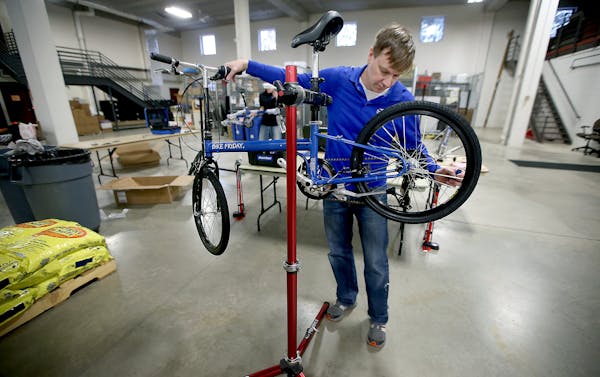The state's bike lobby plans to push at the Legislature for lower speed limits on city streets.
A limit of 25 miles per hour has long been a goal for Minneapolis, St. Paul and other communities. Supporters argue a lower limit would reduce the crash danger for pedestrians and cyclists and get more people out exercising.
The present urban limit of 30 mph was cited by the League of American Bicyclists as an area needing improvement when Minneapolis recently tried unsuccessfully to upgrade its status as a bike-friendly community from gold to platinum, a status held by only five cities nationally.
All four surrounding states allow speed limits of 25 mph in urban areas, an area of contention for some cyclists.
"It doesn't make sense to me that all the states around us have 25 miles per hour and Minnesota doesn't," said Dorian Grilley, executive director of the Bicycle Alliance of Minnesota, which is planning the legislative push. The Minneapolis Bicycle Coalition hasn't adopted a position on lowering the speed limit.
Despite the 30 mph urban speed limit, there are exceptions for 25 mph — on city streets less than a half-mile long, and for park roads, alleys or mobile home parks. A limit of 25 may already be set for a local street with a bike lane, but the provision doesn't appear to be used.
The city of Minneapolis for several years has sought 25 mph as a standard for residential streets in light of their use by children playing, pedestrians and cyclists, according to City Council Member Elizabeth Glidden.
But a key legislator who supports a lower limit warned that the proposal could languish at the State Capitol. Rep. Frank Hornstein, DFL-Minneapolis, said sentiment among outstate legislators has been to push for higher speed limits, particularly on farm-to-market roads. Hornstein is a senior member of the Transportation Policy and Finance Committee.
Moreover, the one test of a lower speed limit on a bike route in Minneapolis produced negligible change in traffic speeds, according to city measurements. Tests in 2012 and 2013 involved a 25 mph limit on 15th Avenue SE. near the University of Minnesota.
"It basically tells me that a sign doesn't change behavior," said Jon Wertjes, the city's director of traffic and parking services.
The feedback report from the League of American Bicyclists said Minneapolis has a low share of streets with a 25 mph speed limit compared to other applicants for the top category of bike-friendly awards. It particularly urged the lower limit for downtown, around schools and in residential neighborhoods. It said that traffic-calming measures, which involve such techniques as speed rises or raised pedestrian crossings, could help compliance by drivers. The report added that pedestrians and cyclists have a 90 percent survival rate if hit at 20 mph or below, but that rate drops to 50 percent at 30 mph or above.
Grilley said he could tell the difference a lower speed limit made when he biked in Fargo, N.D.
"I was wondering why all the cars were going slow," he said. "They must really enforce it. I felt much more comfortable on the road."
Metro Cities used to favor a lower speed limit on residential streets but dropped that several years ago in favor of saying any change in the statutory speed limit should be uniform.
Steve Brandt • 612-673-4438
Twitter: @brandtstrib

Former Gov. Jesse Ventura boasts he could beat unpopular Trump or Biden if he ran for president

Dave Kleis says he won't run for sixth term as St. Cloud mayor
Newspaper boxes repurposed as 'Save a Life' naloxone dispensaries

St. Cloud house vies for Ugliest House in America

